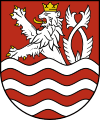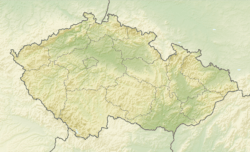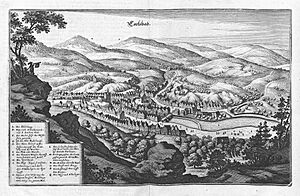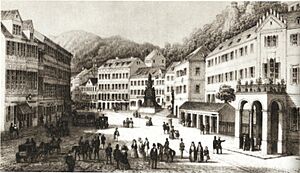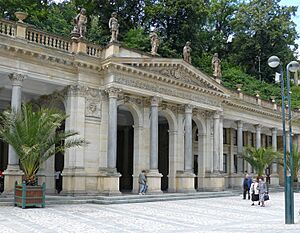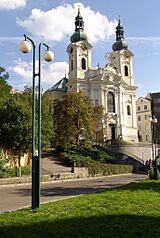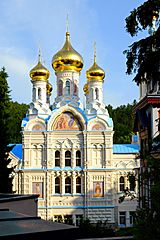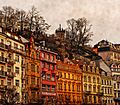Karlovy Vary facts for kids
Quick facts for kids
Karlovy Vary
Karlsbad
|
|||||||||||||
|---|---|---|---|---|---|---|---|---|---|---|---|---|---|
|
Statutory city
|
|||||||||||||

Aerial view of Karlovy Vary
|
|||||||||||||
|
|||||||||||||
| Country | |||||||||||||
| Region | Karlovy Vary | ||||||||||||
| District | Karlovy Vary | ||||||||||||
| Founded around | 1349 | ||||||||||||
| Area | |||||||||||||
| • Total | 59.08 km2 (22.81 sq mi) | ||||||||||||
| Elevation | 447 m (1,467 ft) | ||||||||||||
| Population
(2024-01-01)
|
|||||||||||||
| • Total | 49,353 | ||||||||||||
| • Density | 835.36/km2 (2,163.57/sq mi) | ||||||||||||
| Time zone | UTC+1 (CET) | ||||||||||||
| • Summer (DST) | UTC+2 (CEST) | ||||||||||||
| Postal codes |
360 01, 360 06, 360 07,
360 17, 360 18, 364 64 |
||||||||||||
| Website | www.karlovyvary.cz | ||||||||||||
|
|||||||||||||
Karlovy Vary (which means "Charles' Baths") is a famous spa city in the Karlovy Vary Region of the Czech Republic. It is also known by its German name, Karlsbad. About 49,000 people live there. The city is located where two rivers, the Ohře and Teplá, meet.
Karlovy Vary gets its name from Charles IV, Holy Roman Emperor, who was also the King of Bohemia. He founded the city in the 1300s. The area has many hot springs. Because of these springs, Karlovy Vary became a popular spa resort in the 1800s. Many important people and wealthy families from Europe visited the city.
The city grew very quickly until World War I started. After the Velvet Revolution in 1989, Karlovy Vary became a popular tourist spot again. It is now the most visited spa town in the Czech Republic. It is also the largest spa area in Europe.
In 2021, Karlovy Vary became a World Heritage Site by UNESCO. This happened because of its special spas and beautiful buildings from the 1700s to the 1900s. The old city center, with its spa areas, is very well kept. It is protected by law as an important historical place.
Contents
- City Layout: How Karlovy Vary is Divided
- City Name: What Karlovy Vary Means
- Nature and Weather: Karlovy Vary's Geography and Climate
- History of Karlovy Vary: From Ancient Times to Today
- People of Karlovy Vary: Demographics
- Karlovy Vary's Economy: What the City Makes
- Getting Around: Transport in Karlovy Vary
- Arts and Entertainment: Karlovy Vary's Culture
- Sports in Karlovy Vary: Teams and Clubs
- Places to See: Karlovy Vary's Sights
- Famous People: Those Connected to Karlovy Vary
- Global Connections: Karlovy Vary's Sister Cities
- Images for kids
- See also
City Layout: How Karlovy Vary is Divided
Karlovy Vary is made up of 15 different city parts and villages. One of these parts, Cihelny, is a separate piece of land. It is not connected to the main city area.
City Name: What Karlovy Vary Means
The city is named after its founder, Charles IV, Holy Roman Emperor. The name Karlovy Vary literally means "Charles' Baths." People also used to call it Warmbad, which is German for "hot bath." This name refers to the city's famous hot springs.
Nature and Weather: Karlovy Vary's Geography and Climate
Karlovy Vary is about 106 kilometers (66 miles) west of Prague. The northern part of the city is mostly flat. This is where most of the buildings are. The southern part is hilly and includes the Slavkov Forest. The highest point in the city is Vítkův vrch hill, which is 642 meters (2,106 feet) high.
The city sits where the Ohře, Teplá, and Rolava rivers meet. The Ohře River flows right through the city. There are also a few small lakes in the northern part of Karlovy Vary. The Rolava reservoir is a natural lake in the city center. People use it for fun activities.
Karlovy Vary's Weather: Temperatures and Rainfall
| Climate data for Karlovy Vary (1991−2020 normals, extremes 1961-present) | |||||||||||||
|---|---|---|---|---|---|---|---|---|---|---|---|---|---|
| Month | Jan | Feb | Mar | Apr | May | Jun | Jul | Aug | Sep | Oct | Nov | Dec | Year |
| Record high °C (°F) | 14.2 (57.6) |
16.4 (61.5) |
21.8 (71.2) |
27.7 (81.9) |
31.0 (87.8) |
34.5 (94.1) |
35.8 (96.4) |
35.8 (96.4) |
31.0 (87.8) |
24.7 (76.5) |
17.0 (62.6) |
14.5 (58.1) |
35.8 (96.4) |
| Mean daily maximum °C (°F) | 0.6 (33.1) |
2.2 (36.0) |
6.6 (43.9) |
12.7 (54.9) |
17.1 (62.8) |
20.6 (69.1) |
22.6 (72.7) |
22.4 (72.3) |
17.2 (63.0) |
11.4 (52.5) |
5.1 (41.2) |
1.3 (34.3) |
11.7 (53.1) |
| Daily mean °C (°F) | −1.8 (28.8) |
−1.0 (30.2) |
2.4 (36.3) |
7.5 (45.5) |
12.0 (53.6) |
15.4 (59.7) |
17.2 (63.0) |
16.7 (62.1) |
12.0 (53.6) |
7.2 (45.0) |
2.4 (36.3) |
−0.9 (30.4) |
7.4 (45.3) |
| Mean daily minimum °C (°F) | −4.6 (23.7) |
−4.4 (24.1) |
−1.6 (29.1) |
1.7 (35.1) |
5.9 (42.6) |
9.1 (48.4) |
11.0 (51.8) |
10.6 (51.1) |
7.0 (44.6) |
3.4 (38.1) |
−0.3 (31.5) |
−3.5 (25.7) |
2.9 (37.2) |
| Record low °C (°F) | −23.4 (−10.1) |
−23.2 (−9.8) |
−19.5 (−3.1) |
−11.1 (12.0) |
−5.4 (22.3) |
−1.7 (28.9) |
0.8 (33.4) |
1.5 (34.7) |
−2.8 (27.0) |
−9.5 (14.9) |
−13.8 (7.2) |
−25.1 (−13.2) |
−25.1 (−13.2) |
| Average precipitation mm (inches) | 35.5 (1.40) |
27.8 (1.09) |
34.9 (1.37) |
29.9 (1.18) |
56.5 (2.22) |
71.1 (2.80) |
68.3 (2.69) |
67.0 (2.64) |
55.0 (2.17) |
43.0 (1.69) |
38.9 (1.53) |
40.8 (1.61) |
568.4 (22.38) |
| Average precipitation days (≥ 1.0 mm) | 9.0 | 7.2 | 8.3 | 6.9 | 9.7 | 10.3 | 10.7 | 9.4 | 8.1 | 8.5 | 8.5 | 9.2 | 105.9 |
| Mean monthly sunshine hours | 44.2 | 75.3 | 116.0 | 177.9 | 209.5 | 213.9 | 229.0 | 222.9 | 154.9 | 100.5 | 41.2 | 33.8 | 1,619 |
| Source 1: NOAA | |||||||||||||
| Source 2: Czech Hydrometeorological Institute | |||||||||||||
History of Karlovy Vary: From Ancient Times to Today
People have lived in the Karlovy Vary area for a very long time. An old fortified settlement from the late Bronze Age was found in Drahovice. Slavic people also lived here, as shown by discoveries in Tašovice and Sedlec. People living near the hot springs in the 1200s knew about their healing powers.
From the late 1100s to the early 1200s, German settlers came to the area. They were craftsmen and miners who helped the region grow. Over time, Karlovy Vary became a town where most people spoke German.
Founding of the City: Charles IV and the Hot Springs
The village of Obora, now part of the city, was first mentioned in 1325. Karlovy Vary itself, as a small spa settlement, was likely founded around 1349. A legend says that Charles IV, Holy Roman Emperor was on a hunting trip. His group accidentally found a hot spring. The water from this spring helped heal Charles IV's injured leg.
Because of this, he decided to build a spa there. It was first called "Hot Spas at the Loket." Later, it was named "Karlovy Vary" after the emperor. Charles IV officially gave the town special rights on August 14, 1370.
Karlovy Vary in the 1800s and 1900s
In 1819, an important political meeting happened in Karlovy Vary. Rules called the Carlsbad Decrees were made. These rules aimed to control what people could say and publish.
Doctors like David Becher helped the city become a famous spa resort in the 1800s. Many European noble families and famous people came to visit. The city became even more popular after railway lines were built in 1870. These trains connected Karlovy Vary to other big cities.
The number of visitors grew a lot. In 1756, only 134 families visited. By the late 1800s, about 26,000 guests came each year. The most visitors came in 1911, with almost 71,000 people. However, World War I stopped this growth in tourism. Other big problems for tourism were the worldwide economic crisis and the start of World War II.
After World War I ended in 1918, the German-speaking people in Bohemia became part of the new country of Czechoslovakia. Many German-speaking people in Karlovy Vary were unhappy about this. In 1930, most people in the city were ethnic Germans.
In 1938, Nazi Germany took over the city. It became part of a region called Reichsgau Sudetenland. During World War II, a special prison was set up here. After the war, many German-speaking people moved away from Karlovy Vary.
After the Velvet Revolution in 1989, Karlovy Vary's spas and tourism started to grow quickly again. The old spa buildings were fixed up. The city became a top spa destination in Europe once more. Many visitors and investors from Russia also became interested in the city.
People of Karlovy Vary: Demographics
In 2017, about 7% of the people living in the Karlovy Vary region were not Czech. This is one of the highest percentages in the Czech Republic, after Prague. The largest groups of people from other countries were from Vietnam, Germany, Ukraine, and Russia.
| Historical population | ||||||||||||||||||||||||||||||||||||||||||||||||||||||||
|---|---|---|---|---|---|---|---|---|---|---|---|---|---|---|---|---|---|---|---|---|---|---|---|---|---|---|---|---|---|---|---|---|---|---|---|---|---|---|---|---|---|---|---|---|---|---|---|---|---|---|---|---|---|---|---|---|
|
|
|
||||||||||||||||||||||||||||||||||||||||||||||||||||||
| Source: Censuses | ||||||||||||||||||||||||||||||||||||||||||||||||||||||||
Karlovy Vary's Economy: What the City Makes
Karlovy Vary's economy mainly focuses on services. There are only small and medium-sized factories here. The biggest industries are food and drinks. This includes bottling mineral water and making special treats. Mattoni 1873 is the largest company in the city that makes drinks.
Karlovy Vary is also famous for a Czech liqueur called Becherovka. It has been made here since 1807. The city is also known for Karlovarské oplatky, which are special Carlsbad wafers. These wafers first came from the city in 1867. The city also gave its name to "Carlsbad plums," which are candied stuffed prune plums.
Another important industry is making glass and porcelain. Karlovy Vary is home to Moser Glass. This company makes beautiful lead glass and was started in 1857. It is known as a very fancy Czech brand.
Spa Industry: Healing Waters of Karlovy Vary
Karlovy Vary is the most popular spa town in the Czech Republic. It is part of the West Bohemian Spa Triangle. It is also the biggest spa area in Europe. Karlovy Vary has over 80 hot springs. These springs are in an area where the Earth's plates are active.
All the springs come from the same underground source. This means they all have the same minerals and chemicals. The hottest springs can reach about 74 °C (165 °F). The coolest ones are under 40 °C (104 °F). Together, all the springs produce about 2,000 liters (528 gallons) of water every minute.
Getting Around: Transport in Karlovy Vary
You can get around Karlovy Vary using local buses. There are also cable cars that take people to different parts of the city. The Imperial funicular is the oldest tunnel funicular in Europe. It is also the steepest in the Czech Republic. The Diana funicular was the longest funicular in Austria-Hungary when it was built.
You can reach the city by the D6 motorway. There are also inter-city buses and trains. You can take trains from České dráhy or Deutsche Bahn. The Karlovy Vary Airport is an international airport. It is about 4.5 kilometers (2.8 miles) southeast of the city center.
Arts and Entertainment: Karlovy Vary's Culture
In the 1800s, Karlovy Vary became a popular place for famous people to visit for spa treatments. The city is also known for the Karlovy Vary International Film Festival. This festival is one of the oldest in the world. It is also one of Europe's most important film events.
Karlovy Vary has been used as a filming location for movies. The 2006 films Last Holiday and Casino Royale both used the city's Grandhotel Pupp. The Palace Bristol Hotel in Karlovy Vary was also used as a model for the movie The Grand Budapest Hotel.
Sports in Karlovy Vary: Teams and Clubs
Karlovy Vary is home to a top-level ice hockey team called HC Karlovy Vary. It also has a top-level volleyball team called VK Karlovarsko.
The city's football (soccer) club is FC Slavia Karlovy Vary. This team plays in the third level of the Czech football system.
Places to See: Karlovy Vary's Sights
Karlovy Vary has many important historical buildings. Most of these buildings are connected to the city's spa history. Since 2018, the spa center and the areas around it are protected. They are considered an important historical site. Karlovy Vary is a UNESCO World Heritage Site because of its spas and architecture.
Spa Buildings: Famous Colonnades and Springs
The Císařské lázně spa building is very important. It is a national cultural monument. It was built between 1893 and 1895 in a French Neo-Renaissance style. The largest colonnade is the Mill Colonnade. It has five mineral springs and was built from 1871 to 1881.
The most famous spring is Vřídlo. It is in the Hot Spring Colonnade. This spring shoots water up to 12 meters (39 feet) high like a geyser! Other colonnades include the Park Colonnade, the Market Colonnade, and the Castle Colonnade. Each has its own unique style and history.
Churches: Historic Places of Worship
The Church of Saint Mary Magdalene is a very valuable church. It is a Catholic church built in the Baroque style between 1732 and 1736. It is considered one of the most important Baroque buildings in the Czech Republic. It is also a national cultural monument.
The Church of Saint Peter and Paul is another famous building. It was built in the Byzantine style from 1893 to 1897. It is the largest Orthodox church west of the Post-Soviet states.
The Church of Saint Andrew was built around 1500. A cemetery for spa guests who died in Karlovy Vary was next to it. In 1911, the cemetery became a park called Mozart's Park. It has many old tombstones.
The Church of Saint Anne was built in the Baroque style from 1738 to 1749. It is a pilgrimage church. The Church of Saints Peter and Paul is a different church, built in a Gothic style in the 1850s. Today, it belongs to the Czechoslovak Hussite Church.
The Church of Saint Luke was built in 1876–1877 with money from English spa guests. It used to be a Methodist church. Now, it is a wax museum. The Church of Saint Leonard of Noblac was the oldest church in the area. It was first mentioned in 1246. It is now a ruin in the woods.
Famous People: Those Connected to Karlovy Vary


Many famous people have lived in or visited Karlovy Vary over the years.
- Johann Josef Loschmidt (1821–1895), an Austrian scientist.
- Walter Serner (1889–1942), a writer.
- Zbyněk Brynych (1927–1995), a film director.
- Princess Michael of Kent (born 1945), a member of the British royal family.
- Tomáš Vokoun (born 1976), a famous ice hockey player.
- Hana Soukupová (born 1985), a supermodel.
Historical Figures Who Visited Karlovy Vary
- Peter the Great (1672–1725), the Tsar of Russia, visited in 1711.
- Johann Wolfgang von Goethe (1749–1832), a famous German writer and scientist.
- Ludwig van Beethoven (1770–1827), a famous composer, came for spa treatments. He even performed a concert here in 1812.
- Frédéric Chopin (1810–1849), another famous composer, met his parents here for the last time in 1835.
- Ivan Turgenev (1818–1883), a Russian novelist, visited many times.
- Mustafa Kemal Atatürk (1881–1938), the founder and first President of Turkey, had treatments here in 1918.
Global Connections: Karlovy Vary's Sister Cities
Several places around the world are named after Karlovy Vary's English name, Carlsbad. These include Carlsbad, New Mexico, Carlsbad, California, and Carlsbad, Texas in the United States, and Carlsbad Springs in Canada. They were named this because they also had mineral springs.
Karlovy Vary is also "twinned" with other cities around the world. This means they have special friendly relationships.
 Baden-Baden, Germany
Baden-Baden, Germany Bernkastel-Kues, Germany
Bernkastel-Kues, Germany Carlsbad, United States
Carlsbad, United States Eilat, Israel
Eilat, Israel Kusatsu, Japan
Kusatsu, Japan Locarno, Switzerland
Locarno, Switzerland Varberg, Sweden
Varberg, Sweden
Images for kids
Panorama of Karlovy Vary
See also
 In Spanish: Karlovy Vary para niños
In Spanish: Karlovy Vary para niños



